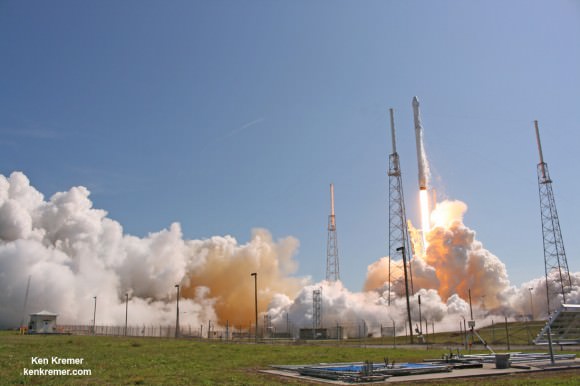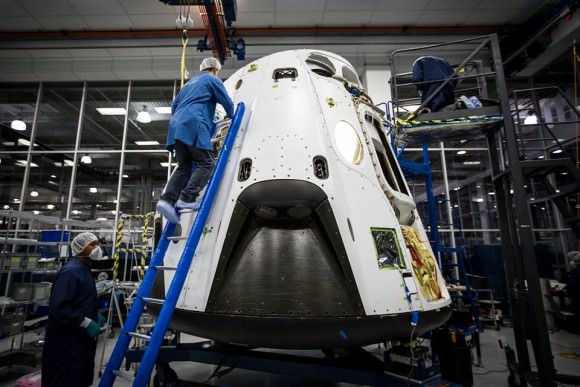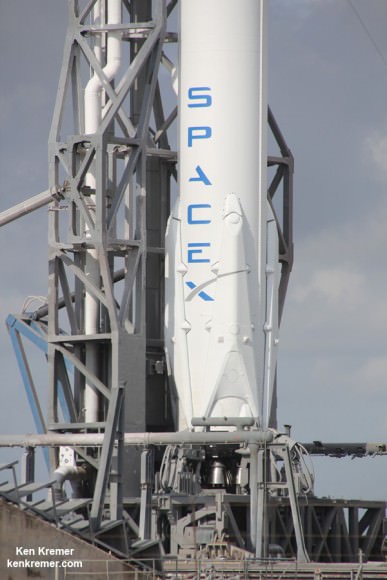SpaceX Dragon V2 test flight vehicle set for May 5, 2015 pad abort test. Credit: SpaceX
See below SpaceX live launch webcast link[/caption]
As promised, SpaceX is picking up its launch pace in 2015 with a pair of liftoffs from the Florida space coast slated for the next week and a half. They follow closely on the heels of a quartet of successful blastoffs from Cape Canaveral, already accomplished since January.
If all goes well, a commercial satellite launch and a human spaceflight related pad abort test launch for NASA are scheduled for April 27 and May 5 respectively.
Mondays launch of a communications satellite for Thales Alenia Space takes place just 13 days after SpaceX successfully launching the Dragon CRS-6 resupply freighter to the International Space Station (ISS) for NASA on April 14.
The 13 day turnaround time will mark a new launch cadence record for SpaceX if the weather and rocket cooperate, eclipsing the 14 day turnaround record set last September.

The 224 foot tall SpaceX Falcon 9 rocket is scheduled to launch at approximately 6:14 p.m. EDT (2214 GMT) on April 27 from Space Launch Complex 40 (SLC-40) at Cape Canaveral Air Force Station, Florida. It will deliver the TurkmenÄlem52E/MonacoSat satellite to a geosynchronous transfer orbit.
This first satellite ever for Turkmenistan will be deployed approximately 32 minutes after liftoff of the fifth Falcon 9 rocket this year.
The outlook is currently 60 percent GO for favorable weather conditions at launch time.
You can watch the launch live via a SpaceX webcast that begins about 20 minutes before launch at: spacex.com/webcast
The May 5 pad abort test for NASA is critical for the timely development of the human rated Dragon that NASA is counting on to restore the US capability to launch astronauts from US soil to the space station.
The test will simulate an emergency abort from a test stand and will also take place from the Cape’s Space Launch Complex 40 in Florida.
SpaceX has a four hour launch window in which to conduct the test. The test window opens at 9:30 a.m. EDT (1330 GMT) on May 5. There is a backup opportunity on May 6.
The pad abort demonstration will test the ability of a set of eight SuperDraco engines built into the side walls of the crew Dragon to pull the vehicle away from the launch pad in a split second in a simulated emergency.

The purpose is to test the ability of the abort system to save astronauts lives in the event of a real emergency.
The SuperDraco engines are located in four jet packs around the base. Each enigne can produce up to 120,000 pounds of axial thrust to carry astronauts to safety, according to a SpaceX description.
Here is a SpaceX video of SuperDraco’s being hot fire tested in Texas.
Video caption: Full functionality of Crew Dragon’s SuperDraco jetpacks demonstrated with hotfire test in McGregor, TX. Credit: SpaceX
The pad abort test is being done under SpaceX’s Commercial Crew Integrated Capability (CCiCap) agreement with NASA.
The initial pad abort test will test the ability of the full-size Dragon to safely push away and escape in case of a failure of its Falcon 9 booster rocket in the moments around launch, right at the launch pad.
“The purpose of the pad abort test is to demonstrate Dragon has enough total impulse (thrust) to safely abort,” SpaceX spokeswoman Emily Shanklin informed me.
For that test, Dragon will use its pusher escape abort thrusters to lift the Dragon safely away from the failing rocket.
The vehicle will be positioned on a structural facsimile of the Dragon trunk in which the actual Falcon 9/Dragon interfaces will be represented by mockups. The test will not include an actual Falcon 9 booster.
A second Dragon flight test follow later in the year. It involves simulating an in flight emergency abort scenario during ascent at high altitude at maximum aerodynamic pressure at about T plus 1 minute, to save astronauts lives. The pusher abort thrusters would propel the capsule and crew safely away from a failing Falcon 9 booster for a parachute assisted landing into the Atlantic Ocean.
The SpaceX Dragon V2 and Boeing CST-100 vehicles were selected by NASA last fall for further funding under the auspices of the agency’s Commercial Crew Program (CCP), as the worlds privately developed spaceships to ferry astronauts back and forth to the International Space Station (ISS).
Both SpaceX and Boeing plan to launch the first manned test flights to the ISS with their respective transports in 2017.
During the Sept. 16, 2014 news briefing at the Kennedy Space Center, NASA Administrator Charles Bolden announced that contracts worth a total of $6.8 Billion were awarded to SpaceX to build the manned Dragon V2 and to Boeing to build the manned CST-100.
There will be no attempt to soft land the Falcon 9 first stage during the April 27 launch. The next landing attempt is set for mid-June.

Stay tuned here for Ken’s continuing Earth and planetary science and human spaceflight news.


Yeah, yeah, yeah! Go Space X!
update: launch was successful. replay video here:
http://www.spacex.com/webcast/
The loss of the current Russian resupply flight seems almost immanent, meaning that there will probably be a lengthy investigation into the mishap? If so, it will probably stall the next re-supply flight and even the next manned launch! Can or will Space X step up to the plate and double up resupply missions? Could they? They might have to…